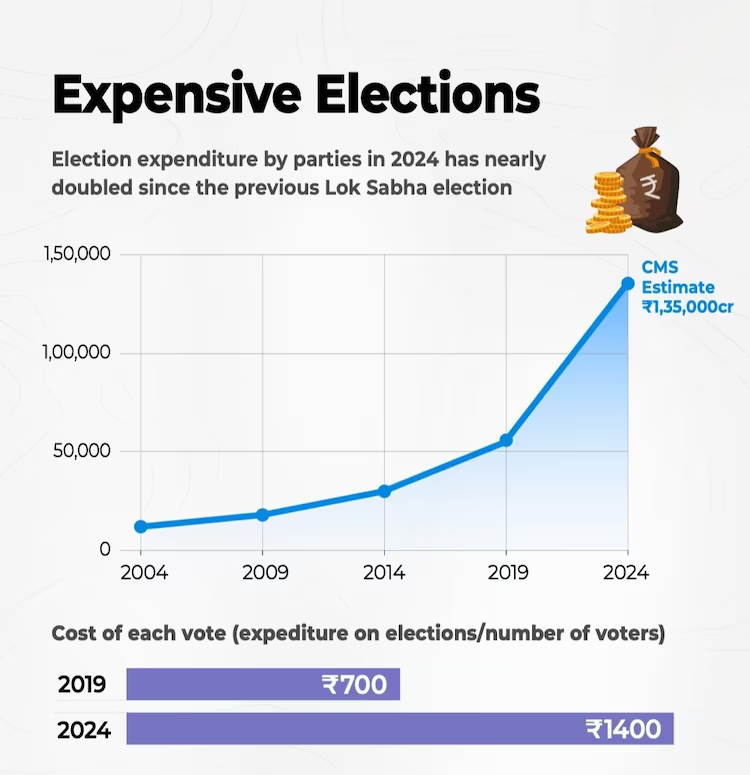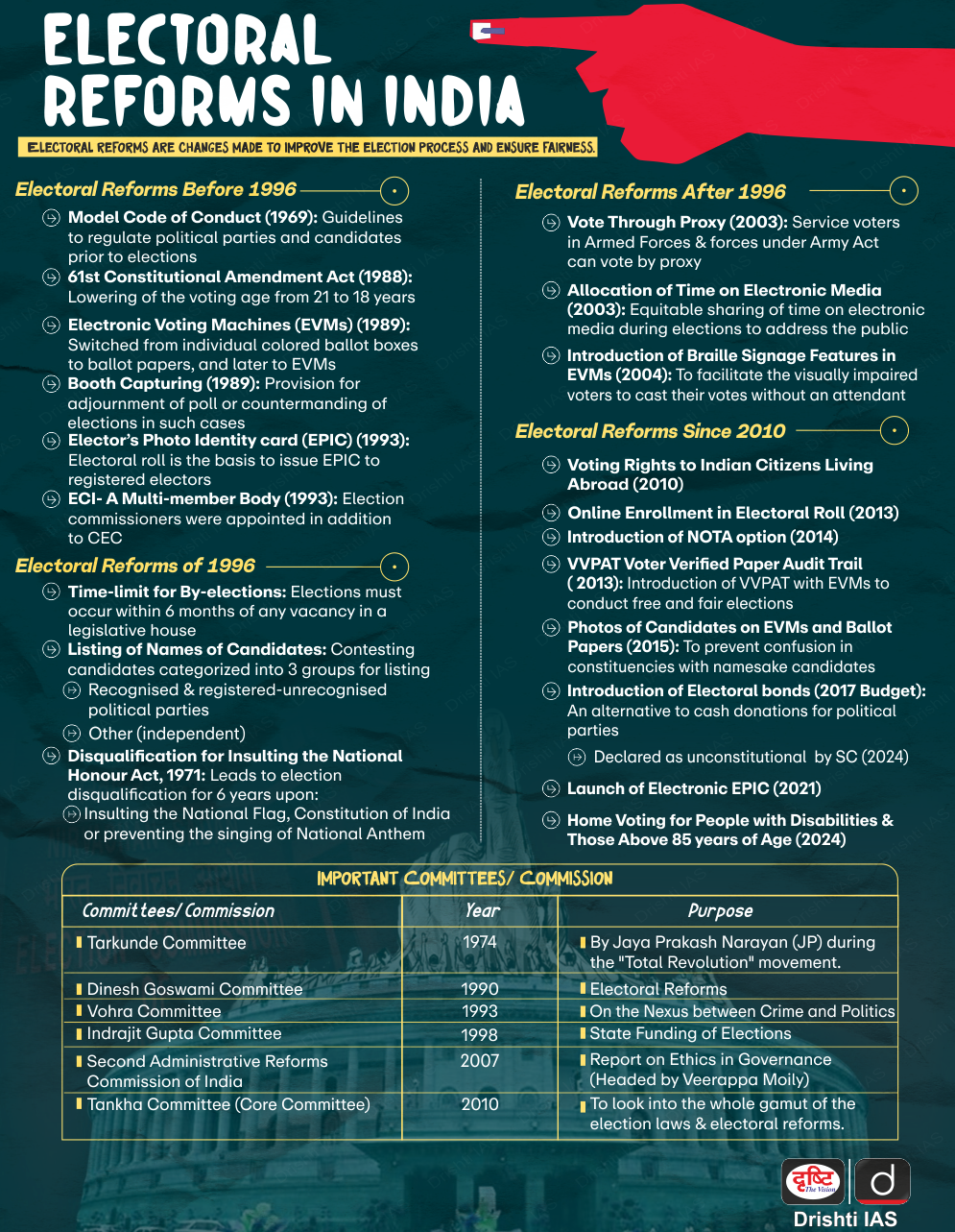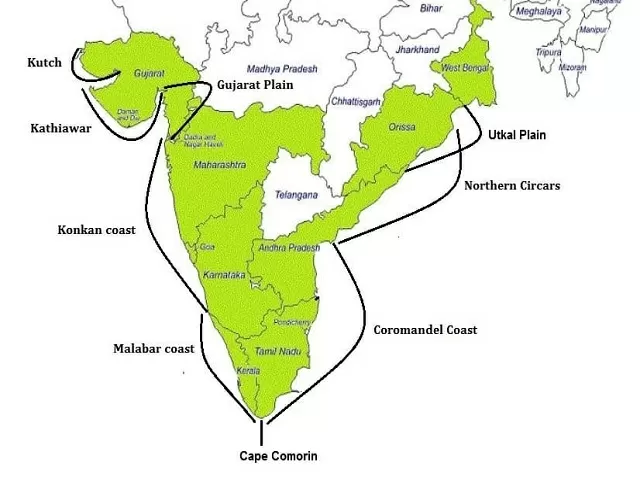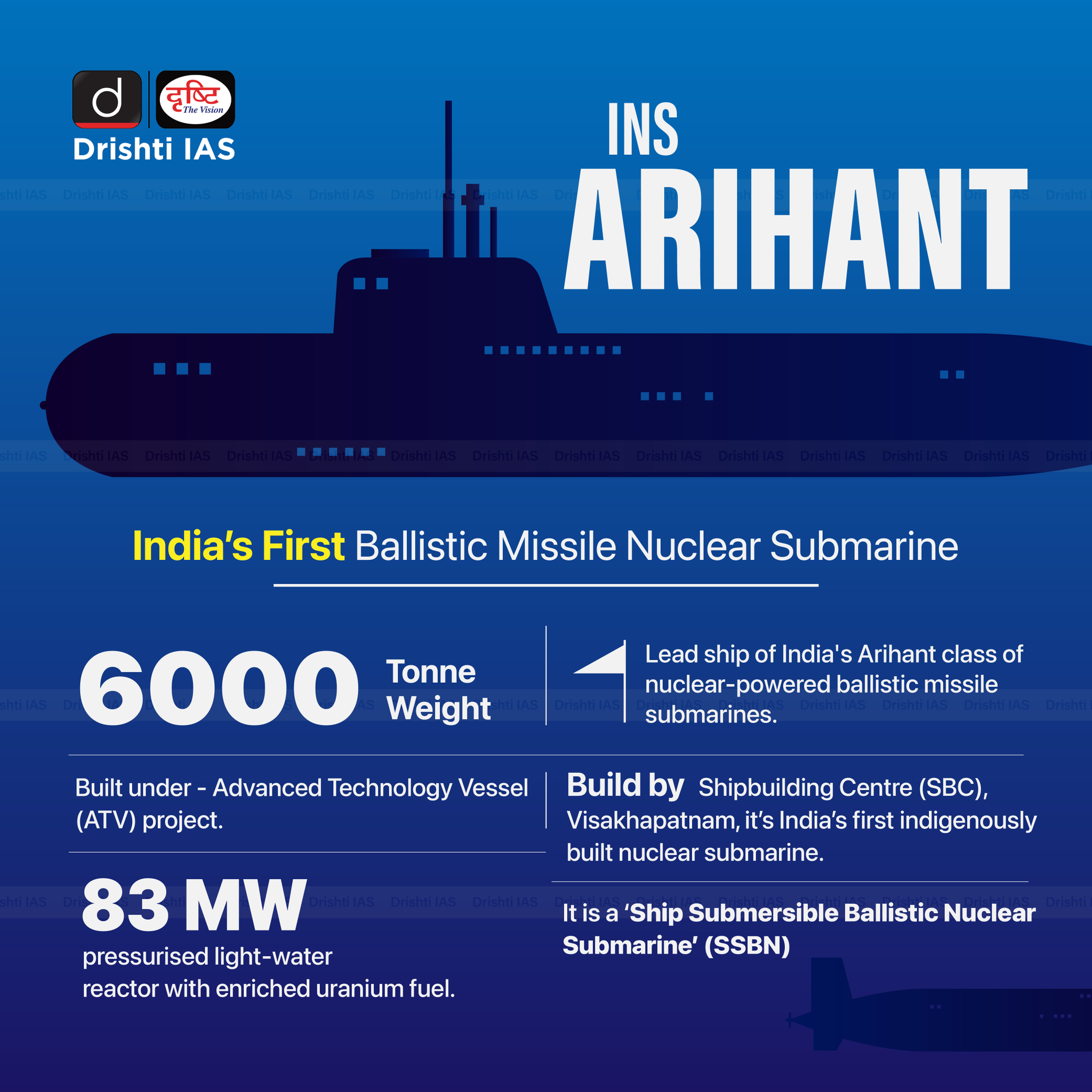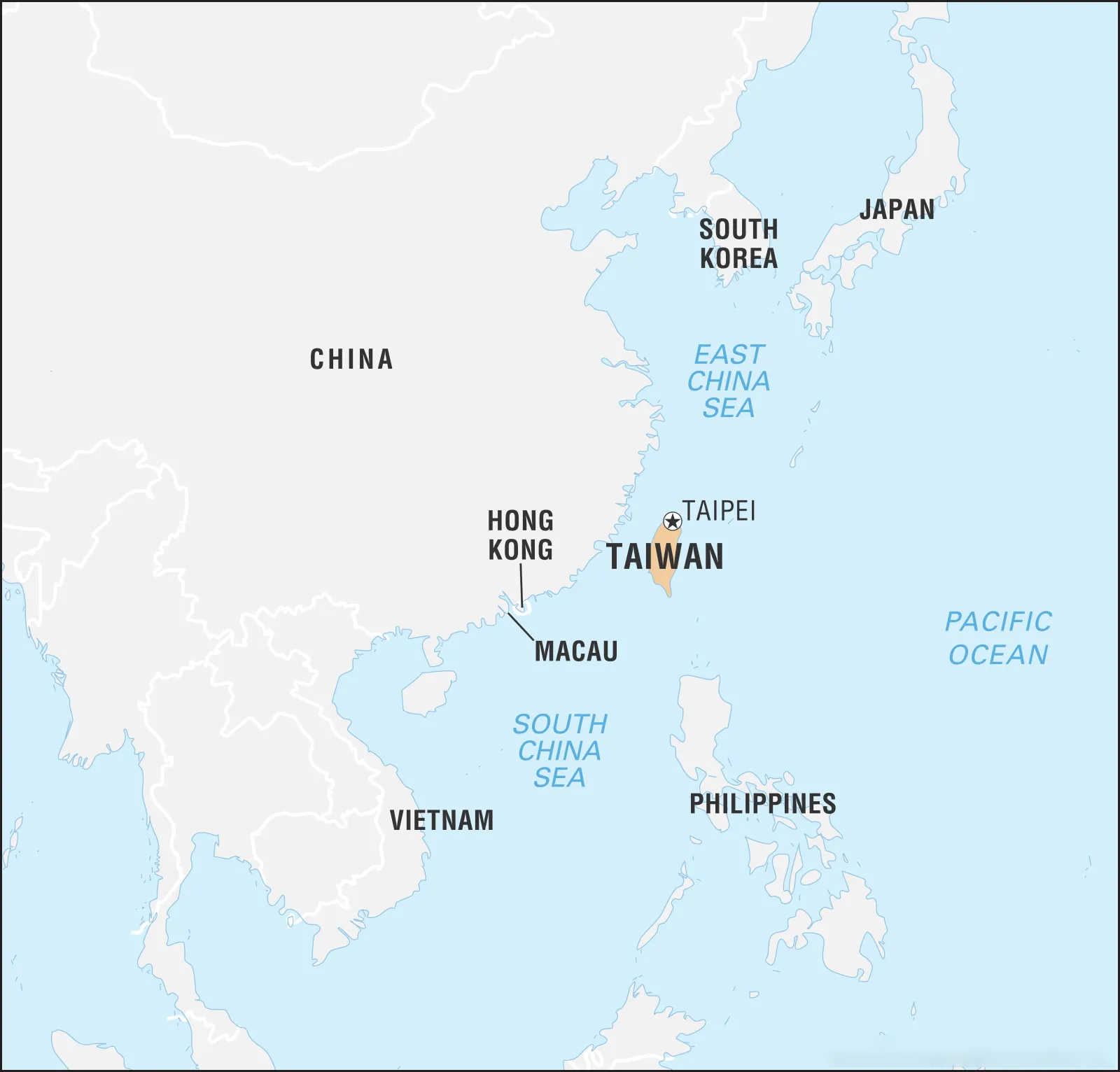Limiting Expenditure on Elections
For Prelims: Not-For-Profit Organisation, Lok Sabha, General Elections, House of Representatives, National Party, State Parties, Election Commission of India, Indrajit Gupta Committee, Law Commission, State Funding for Elections.
For Mains: Excessive expenditure on elections, their impacts and ways to address them.
Why in News?
According to the Centre for Media Studies (CMS), the total expenditure by various political parties for the general election to Lok Sabha 2024 was around Rs 1,00,000 crores.
- CMS is a not-for-profit organisation that works towards responsive governance and equitable development.
What is the Status of Election Expenditure in India?
- Expenditure Limit on Candidates: The election expenditure limit for candidates is set at Rs 95 lakh for Lok Sabha seats and Rs 40 lakh for Assembly seats in larger states, and Rs 75 lakh and Rs 28 lakh respectively in smaller states.
- Political Party Spending: Currently, there are no expenditure limits imposed on political parties during elections, allowing them unrestricted spending.
- In the 2024 Lok Sabha Election, the cost of a single vote in India has amounted to around Rs 1,400 and total expenditures reached approximately Rs 1 lakh crores.
- Promoting Schemes: Government advertisements, especially before elections, often serve as campaigns for the ruling party.
- The Central government spent Rs 3,020 crore on advertisements between 2018-19 and 2022-23, with higher spending in election years—Rs 1,179 crore in 2018-19 versus Rs 408 crore in 2022-23.
- Comparison with Previous Elections: Candidates initially spent only Rs 25,000 during the first general elections in 1951-52 which now skyrocketed to Rs 75-95 lakh (300-fold increase).
- Additionally, overall election expenditure has risen sixfold from Rs 9,000 crore in 1998 to approximately Rs 1,00,000 crores in 2024.
- Transparency Measures: Political parties are required to submit annual contribution reports to the Election Commission of India (ECI) for donations exceeding Rs 20,000.
- They must also provide Annual Audited Accounts (AAA) and election expenditure reports within 75 days post-election.
- Funding Sources: The vast majority of political funding comes from corporate entities and businesses, creating a strong nexus between donors and politicians.
Status of Election Expenditure in Other Democracies
- United States: In the US, election financing is predominantly derived from limited contributions made by individuals, corporations, and Political Action Committees (PACs).
- US Supreme Court rulings have facilitated the emergence of Super PACs, which can spend unlimited amounts on political campaigning.
- United Kingdom: Political parties face specific expenditure limits when contesting elections.
- Each party is permitted to spend £54,010 for each constituency they contest, leading to an overall cap of £35 million for parties contesting all constituencies.
- During the long campaign phase (five months before the House of Commons term ends), candidates can spend £46,000 to £49,000 per constituency. In the short campaign period (after election announcement), spending is limited to £17,000 to £20,000 per constituency.
How is Election Expenditure Govern in India?
- Representation of the People Act (RPA), 1951:
- Section 77 of the RPA requires candidates to keep a detailed and accurate account of all expenses related to their campaign from the day they file their nomination until the election day.
- Section 78 mandates that every candidate submit their election expense account to the District Election Officer within 30 days of the result declaration.
- Companies Act, 2013: A non-government company with at least three years in operation may contribute up to 7.5% of its average net profits from the last three years to political parties registered under the RPA.
- Foreign Contribution (Regulation) Act (FCRA), 2010: Political parties, candidates, and election-related entities in India are prohibited from receiving foreign contributions.
- This includes funds, gifts, donations, and any financial support from foreign sources.
What are Challenges Associated with Election Expenditure in India?
- Absence of Regulation: Unlike 65 countries, including the US, UK, Canada, and Brazil, India has no limits on political party expenditures during elections.
- It leads to an uneven playing field, favouring well-funded national parties over regional and independent candidates.
- Media Advertising: National and state-level parties allocate a substantial portion of their budgets to media advertisements, surpassing expenditures for grassroots activities like rallies.
- It can marginalise candidates without access to significant financial resources.
- Disproportionate Digital Advertising: The growing influence of digital platforms like Google and Meta (facebook) has widened the spending gap, with national parties investing significantly more in digital advertising than state parties.
- This trend exacerbates existing inequalities and reduces the visibility of smaller parties and candidates.
- Risk of Unaccounted Money: The absence of regulation for third-party campaigners raises concerns about unaccounted money flooding the electoral process.
- There is a heightened risk of quid pro quo arrangements where financial contributions influence political decisions without proper accountability.
What Reforms are Needed in Election Expenditure?
- Expenditure Ceilings: As per the ECI’s ‘Proposed Electoral Reforms’ report in 2016, expenditure ceilings for political parties should be introduced in India.
- It will ensure a more equitable playing field to encourage parties to compete based on ideas rather than financial clout.
- Regulation of Third-Party Campaigners: India should implement formal registration and disclosure requirements for third-party campaigners like Australia.
- State Funding of Elections: The Indrajit Gupta Committee (1998) and the Law Commission report (1999) have recommended state funding for elections, whereby the government would partially finance the election expenditures of candidates nominated by recognised political parties.
- Ban on Government Advertisements: A ban on government advertisements during the six months leading up to elections should be enforced to reduce the advantage held by the ruling party and promote fair competition among candidates.
- Party Financial Assistance: The law must be amended to explicitly provide that ‘financial assistance’ by a political party to its candidate should also be within the candidate’s prescribed election expenditure limits.
- It would close loopholes that allow parties to circumvent spending regulations.
- Comprehensive Electoral Oversight: Establishing an independent electoral oversight body could enhance accountability in campaign financing.
|
Drishti Mains Question: Discuss the challenges associated with election expenditure in India. How can these challenges be addressed? |
UPSC Civil Services Examination Previous Year Questions (PYQ)
Prelims
Q. Consider the following statements: (2017)
- The Election Commission of India is a five-member body.
- Union Ministry of Home Affairs decides the election schedule for the conduct of both general elections and bye-elections.
- Election Commission resolves the disputes relating to splits/mergers of recognised political parties.
Which of the statements given above is/are correct?
(a) 1 and 2 only
(b) 2 only
(c) 2 and 3 only
(d) 3 only
Ans: (d)
Mains
Q. To enhance the quality of democracy in India the Election Commission of India has proposed electoral reforms in 2016. What are the suggested reforms and how far are they significant to make democracy successful? (2017)
Differential Impact of Coastal Flooding on Tree Species
For Prelims: Global warming, Coastal Flooding, Forest Conservation Act of 1980, National Forest Policy of 1988
For Mains: Sea-level rise, and their implications for coastal communities and ecosystems, Impacts of Floods in India.
Why in the News?
A recent study in Frontiers in Forests and Global Change highlights that rising sea levels, driven by global warming, result in varying effects on coastal tree species as a result of coastal flooding.
Note:
- The study used dendrochronology (tree-ring dating) and a machine-learning technique called gradient-boosted linear regression to examine how rainfall, temperature, and tidal levels affect tree growth, revealing complex interactions between these factors.
What are the Key Findings of the Study?
- Diverse Effects on Tree Species: The study indicates that species like American holly (Ilex opaca) prosper with elevated water levels, while loblolly pine (Pinus taeda) and pitch pine (Pinus rigida) show restricted growth under these conditions.
- Resilience by Species: Certain species are better suited to adapt to shifts in precipitation, temperature, and sea levels.
- Trees are adapting rapidly to these changes; as sea levels rise by a few millimetres(mm) each year, many coastal tree species are gradually migrating inland to regions with lower tides and reduced salt exposure.
- Broader Impact: Over three billion people reside near coastlines and depend on coastal ecosystems. Protecting coastal vegetation is essential for sustaining ecosystem services and supporting livelihoods.
- Future Implications: Since 1993, sea levels have doubled their rise from 2mm per year, with researchers forecasting a threefold increase in coastal floods and double the flood days by 2050.
- Study Relevance: Findings help forest managers prioritize species protection in coastal areas, emphasizing the importance of local conditions in assessing forest vulnerability to climate change.
What is Coastal Flooding?
- About: Coastal flooding is a sudden inundation of coastal areas caused by short-term water level increases from storm surges and extreme tides, influenced by local topography and bathymetry.
- Mechanisms of Coastal Flooding:
- Overtopping: Waves can breach barriers like seawalls or dikes, leading to flooding behind these defences.
- Inundation: High sea levels or extreme weather can flood low-lying coastal areas even without overtopping.
- Backflow: Storm surges or high tides can overwhelm rivers or drainage, causing water to flow back into coastal zones.
Overview of India's Coastal Landscape
- India’s coastline stretches 7,516.6 km, with 6,100 km along the mainland and 1,197 km around its islands, spanning 13 States and Union Territories.
- Among the states, Gujarat has the longest coastline (1,214.7 km), followed by Andhra Pradesh (973.7 km) and Tamil Nadu (906.9 km).
- The Andaman & Nicobar Islands hold the longest coastline among UTs at 1,962 km.
- Vulnerable Areas:
- Vulnerable Coastal States: Coastal states like Odisha, Andhra Pradesh, Tamil Nadu, Kerala, West Bengal, Gujarat, and Maharashtra face heightened risks due to their geographic exposure and socio-economic conditions.
- Low-Elevation Flood Risks: Regions with low elevation, such as the Sundarbans in West Bengal and Odisha's coastal plains, are particularly prone to coastal flooding.
How does Global Warming Impact Coastal Region?
- Sea-Level Rise: As global temperatures increase, glaciers and ice sheets melt, adding more water to the oceans and contributing to sea-level rise.
- Increased Coastal Flooding: Higher sea levels and stronger storm surges result in more frequent and intense coastal flooding, impacting infrastructure and habitats.
- Erosion of Coastlines: The combination of rising seas and more powerful storms accelerates erosion, causing the loss of beaches and wetlands that act as natural buffers.
- Impact on Marine Ecosystems: Changes in ocean temperatures and acidification due to increased CO₂ affect marine life, including coral reefs, fish populations, and biodiversity crucial to coastal economies.
- Increased Storm Intensity: Warmer seas contribute to more powerful tropical storms and hurricanes, resulting in destructive storm surges that threaten coastal communities.
What are India's Initiatives for Coastal Management?
- Managing Coastal Flood: MISHTI Initiative, a government-led initiative aimed at increasing the mangrove cover along the coastline and on saltpan lands.
- National Centre for Sustainable Coastal Management: It aims to promote integrated and sustainable management of the coastal and marine areas in India for the benefit and well-being of the traditional coastal and island communities.
- Integrated Coastal Zone Management Plan: It is a process for the management of the coast using an integrated approach, regarding all aspects of the coastal zone, including geographical and political boundaries, in an attempt to achieve sustainability.
- Coastal Regulation Zone: The Coastal Regulation Zone notification was issued in 1991 under the Environmental Protection Act, 1986, by theMinistry of Environment, Forest and Climate Change to regulate activities in coastal areas of India.
- Solutions for Flood Management:
- Storage Reservoirs: These man-made structures retain water during periods of high flow and discharge it when flows are low.
- Embankments: These are raised structures that confine the flow of water within a channel or along a bank.
- Flood Forecasting and Warning: This system predicts potential floods using meteorological and hydrological data.
- For instance, the Central Water Commission (CWC) runs a network of flood forecasting stations in India, providing daily updates and alerts on flood conditions.
What are the Challenges Related to Coastal Flooding?
- Infrastructure Damage: Coastal flooding severely damages infrastructure like roads, buildings, ports, and bridges, leading to high repair costs and disrupting transportation and communication systems in coastal areas.
- Economic Losses: Industries such as tourism, fisheries, and agriculture suffer due to flooding, with coastal regions facing direct losses from halted operations, reduced productivity, and damaged assets.
- Loss of Biodiversity: Flooding leads to habitat loss for coastal flora and fauna, impacting biodiversity. Wetlands, mangroves, and other critical ecosystems are particularly vulnerable, leading to reduced natural resilience against future flooding.
- Saltwater intrusion from coastal flooding contaminates freshwater resources, affecting drinking water, agriculture, and local ecosystems.
- Soil salinity also disrupts crop production, impacting food security in affected regions.
- Displacement and Human Migration: Persistent flooding can render areas uninhabitable, forcing communities to relocate.
- This results in internal migration, strain on urban infrastructure, and potential social conflicts in destination areas.
What Strategies Can Protect Forests from Coastal Flooding?
- Forest Resilience: Forest managers should inventory species composition to prioritize forests that are most at risk, rather than applying blanket strategies.
- Coastal habitats such as Mangroves, Coral Reefs and lagoons are recognized as the best defence against sea storms and erosion, deflecting and absorbing much of the energy of sea storms.
- For example, forests dominated by loblolly pine may need more urgent interventions due to their susceptibility to tidal flooding.
- Localized studies: Localised studies such as soil health and rainfall, are crucial to understanding the site-specific challenges that coastal ecosystems face and for assessing coastal forests' vulnerability to sea-level rise, not just flooding.
- Dune Construction and Restoration: Building or restoring sand dunes can act as a buffer against high tides and storm surges.
- Species Selection: Choosing salt-tolerant and flood-resistant tree species can help sustain forest health in flood-prone areas
- Infrastructure and Engineering Solutions: Exploring innovative engineering solutions like seawalls, levees, and stormwater management systems.
|
Drishti Mains Question: Analyze the impact of rising sea levels on coastal tree species and discuss the implications for forest management and conservation strategies in the context of climate change. |
UPSC Civil Services Examination Previous Year’s Question (PYQs)
Prelims:
Q. La Nina is suspected to have caused recent floods in Australia. How is La Nina different from El Nino? (2011)
- La Nina is characterised by an usually cold ocean temperature in the equatorial Indian Ocean whereas El Nino is characterised by unusually warm ocean temperature in the equatorial Pacific Ocean.
- El Nino has an adverse effect on the south-west monsoon of India but La Nina has no effect on the monsoon climate.
Which of the statements given above is/are correct?
(a) 1 only
(b) 2 only
(c) Both 1 and 2
(d) Neither 1 nor 2
Ans: (d)
Mains
Q. With reference to the National Disaster Management Authority (NDMA) guidelines, discuss the measures to be adopted to mitigate the impact of recent incidents of cloudbursts in many places of Uttarakhand. (2016)
Stem Cell Transplants
Why in News?
A recent study published in Science Translational Medicine examined long-term outcomes in patients who underwent hematopoietic stem cell transplants (HSCT), focusing on how transplanted stem cells evolve and mutate over time.
What are the Key Findings of the Study?
- The research involved 16 pairs of donors and recipients where both exhibited surprisingly low mutation rates, average 2% in donors and 2.6% in recipients annually.
- This finding suggests a stable clonal expansion of stem cells over decades.
- While all donors exhibited some level of clonal hematopoiesis, the absence of widespread clonal expansion indicates a robust regenerative capacity of the bone marrow.
- Implications:
- Crucial for improving long-term transplant outcomes.
- Potential risk of developing blood cancers or chronic diseases in recipients due to the presence of clonal hematopoiesis
Note:
Clonal hematopoiesis occurs when one type of blood cell increases in number compared to others in the blood system. Common examples of this condition include chronic myeloid leukemia and myelodysplastic syndromes (MDS).
What are Hematopoietic Stem Cells ?
- Stem Cells: Stem cells are the body's raw materials — cells from which all other cells with specialised functions are generated.
- Hematopoietic Stem Cells (HSC): They are immature cells capable of developing into all blood cell types, including white blood cells, red blood cells, and platelets. It was first explored for use in humans in the 1950s.
- Hematopoietic stem cells are located in peripheral blood and bone marrow, also known as blood stem cells.
- Transplant of HSCs: It involves administering healthy hematopoietic stem cells to patients with dysfunctional or depleted bone marrow.
- Hematopoietic stem cell transplants can save lives for those with blood cancers.
- After the transplant, the donated stem cells help restore the recipient's blood cell production system.
UPSC Civil Services Examination, Previous Year Questions (PYQs)
Prelims:
Q1. In the context of hereditary diseases, consider the following statements: (2021)
- Passing on mitochondrial diseases from parent to child can be prevented by mitochondria replacement therapy either before or after in vitro fertilization of the egg.
- A child inherits mitochondrial diseases entirely from mother and not from father.
Which of the statements given above is/are correct?
(a) 1 only
(b) 2 only
(c) Both 1 and 2
(d) Neither 1 nor 2
Ans: (c)
Q2. With reference to ‘stem cells’, frequently in the news, which of the following statements is/are correct? (2012)
- Stem cells can be derived from mammals only
- Stem cells can be used for screening new drugs
- Stem cells can be used for medical therapies
Select the correct answer using the codes given below:
(a) 1 and 2 only
(b) 2 and 3 only
(c) 3 only
(d) 1, 2 and 3
Ans: (b)
Anti-Submarine Ship Abhay
Recently, the 7th Anti-Submarine Warfare Shallow Water Craft (ASW SWC), Abhay was launched.
- Over 80% of the Abhay's content is indigenous demonstrating India’s commitment to self-reliance in defence manufacturing.
- The Ministry of Defence (MoD) signed a contract with Garden Reach Shipbuilders & Engineers (GRSE), Kolkata, to build eight ASW SWC ships.
- Its capabilities include search attack unit (SAU) and coordinated ASW operations with aircraft, interdiction/destruction of sub-surface targets in coastal waters.
- It can be deployed in Low-Intensity Maritime Operations (LIMO) and Mine Laying Operations.
- It has low-frequency variable depth sonar, hull-mounted sonar, and expendable bathythermograph.
- Bathythermographs detect changes in water temperature with changing depth.
- These vessels are propelled by water jets and are loaded with anti-submarine weapons like lightweight Torpedoes.
- They are part of the Arnala-class, intended to replace the in-service Abhay-class ASW Corvettes.
Read More: Anti-Submarine Warfare Launch
Taipei Economic and Cultural Centre (TECC)
Recently, China has expressed its opposition to the Taiwanese government establishing the Taipei Economic and Cultural Centre (TECC) in Mumbai. It is Taiwan’s third office in India, following the openings in New Delhi (1995) and Chennai (2012).
- About TECC:
- In 1993, India and Taiwan set up representative offices: the India-Taipei Association in Taipei and the TECC in New Delhi.
- Other countries, like the US, Australia, and Russia, also maintain such centers to support visa services and cultural-economic exchanges.
- China’s Stand on TECC:
- China’s official stance is that there is only one China, which includes Taiwan as an inseparable part, with the People’s Republic of China (PRC) as the sole legitimate government.
- India recognised the PRC in 1950, becoming one of the earliest countries to do so, and does not officially recognise Taiwan.
- India-Taiwan Relations:
- After Independence, India did not formally recognize Taiwan or the Republic of China, lacking diplomatic relations with Taiwan. However, in 1995, India and Taiwan established unofficial relations, opening representative offices.
- Over the years, India's approach to Taiwan has changed significantly, with relations advancing considerably.
- India’s economic rise and growing international profile in the 2000s facilitated Taiwan's engagement with India.
- A 2023 press release from Taiwan’s Foreign Ministry noted India-Taiwan trade growth from USD 2 billion in 2006 to USD 8.9 billion in 2021.
- As a key tech hub and top semiconductor producer, Taiwan shares India’s interest in stronger ties, with its 2016 "New Southbound Policy" aiming to reduce reliance on single markets, especially China.
Read More: China-Taiwan Conflict

